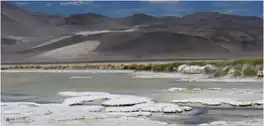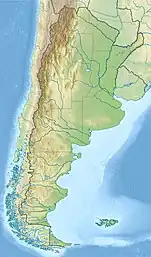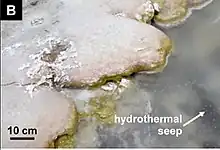Laguna Socompa
| Laguna Socompa | |
|---|---|
 | |
 Laguna Socompa | |
| Coordinates | 24°31′27″S 68°12′26″W / 24.52417°S 68.20722°WCoordinates: 24°31′27″S 68°12′26″W / 24.52417°S 68.20722°W |
| Surface area | 2 square kilometres (0.77 sq mi) |
| Average depth | 0.45–0.62 metres (1 ft 6 in – 2 ft 0 in) |
| Shore length1 | 5 kilometres (3.1 mi) |
| 1 Shore length is not a well-defined measure. | |
Laguna Socompa is a small lake in the Salta Province of Argentina, at the foot of Socompa volcano. It covers an area of about 200 hectares (490 acres) and has an average depth of about 0.45–0.62 metres (1 ft 6 in – 2 ft 0 in). The lake is fed by arroyos and springs, some of which are hot springs. Its waters are very rich in arsenic and otherwise salty and slightly alkaline; these properties and the regionally high UV radiation give Laguna Socompa extreme environmental conditions.
The lake features the world's highest known stromatoliths, mineralized structures formed by microorganisms. Stromatolith-forming microbes were the dominant lifeforms on Earth fossilized between 3.5 and 1.5 billion years ago and may give insight on early life on Earth. These stromatoliths are found on the southern shore of the lake and led to Laguna Socompa being declared a protected area.
Geography and geomorphology
Laguna Socompa is located at an elevation of 3,570 metres (11,710 ft)[1] in the Los Andes Department of the Salta Province in Argentina, close to the border with Chile. A railway to the border with Chile passes east of Laguna Socompa; the Socompa railway station lies c. 10 kilometres (6.2 mi) north-northwest of the lake and the Quebrada del Agua station northeast of the lake is even closer.[2] The area is far away from any city or town[3] and road access is only "incipient"[4] but sodium sulfate was produced in the area of Laguna Socompa.[5] The lake was defined a protected area in 2011[6] but is also in the area of the Socompa geothermal power prospect.[7]
The lake covers a surface of about 200 hectares (490 acres)[8] and has the form of an "L" upside down and backwards. Its depth fluctuates between 0.45–0.62 metres (1 ft 6 in – 2 ft 0 in)[2] with lower water levels during December to May.[3] Twelve terraces surrounding the lake testify to higher water levels in the past.[9] The northwestern and eastern shores feature well developed wetland vegetation[2] and are about 5 kilometres (3.1 mi) long, while dry beaches are found elsewhere along the shore. Sandy-stony ground with bush vegetation characterizes the surrounding landscape[8] which is in general mountainous.[10] Reportedly, the area of the lake smells of sulfur.[11]
Some arroyos enter into Laguna Socompa,[12] and on the eastern side water flows from the Quebrada del Agua spring towards the lake; part of its water is piped to an old mill at the railway. Additional springs[13] occur around[8] and within the lake. On the western-southwestern margins of the lake,[13] hot springs with temperatures of up to 26 °C (79 °F)[14]–27.5 °C (81.5 °F) are found; volcanic activity represented by the Socompa volcano is responsible for heating the waters of the hot springs. The activity of the hot springs has resulted in the deposition of diatomite[10] and sodium sulfate along the shores.[13] The existence of a hydrothermal system in the area has been inferred.[15]
The waters of the lake are somewhat alkaline,[16] turbid, brackish[2] to hypersaline[14] and have a high arsenic content.[17] Salinity increases towards the east.[4] The lakefloor is covered by material with a composition resembling brine, clay and silt.[8] Oncolites have also been reported from Laguna Socompa[18] and there are diatomite deposits left by the lake.[9]
The lake is situated at the foot of the active volcano Socompa[16] within a depression at its foot; the depression was formerly a north-northwest trending valley[19] before the volcano grew in the valley.[20] The volcano features steaming ground and fumaroles at its summit.[7] Lava domes lie along the margins of the Laguna Socompa depression,[21] which may be a cryptic caldera.[22] The region is dominated by long mountain ranges and high volcanoes[23] such as the 5,317 metres (17,444 ft) high Cerro Mellado south of Laguna Socompa.[24] The name of a neighbouring mountain may be a reference to the lake.[25]
Climate and environment
The lake is part of the windy,[23] cold, dry Puna where temperatures vary strongly between day and night, precipitation only occurs in summer.[2] In summer temperatures range from 20 to −10 °C (68 to 14 °F) and in winter from 10 to −40 °C (50 to −40 °F).[4] The region has the highest solar flux in the world, including the largest amount of ultraviolet radiation.[16]
The small lakes in the Puna desert are influenced by extreme environmental conditions such as large amounts of toxic elements such as arsenic, high salinity and strong ultraviolet radiation[26] as the ozone column is less dense at high elevations;[1] these lakes in general receive more insolation than any other place on Earth.[27] Because of the dry climate, most of the lakes lose water mainly through evaporation and thus tend to accumulate salt and arsenic.[28]
Biology
Small lakes in the Puna are places where birds concentrate in comparison to the surrounding environments. About 27 bird species have been observed at Laguna Socompa, including both waterbirds and terrestrial birds; the most common are Anas flavirostris (yellow-billed teal), Hirundo rustica (barn swallow), Larus seranus, Lessonia rufa (austral negrito) and Lophonetta specularioides (crested duck).[29] Among mammals, vicuñas have been reported.[30] Crustaceans and insects have not been reported from the lake.[31]
The vegetation in the wetlands around the lake is characterized by Cyperaceae and Graminaceae.[8] Underwater vegetation does not occur in Laguna Socompa owing to the brackish water.[32] There is little phytoplankton in the lake waters, mainly cyanobacteria and diatoms.[3]
Microorganisms
Microorganisms that live in the lakes and wetlands of the dry Andes have to resist harmful environmental traits[28] and thus become extremely hardy with e.g. high UV radiation tolerance. They often also produce secondary metabolites that are of interest to the industry, such as medicine, UV blocking and bioremediation,[27] which has spurred research in these extreme environments.[1] Furthermore, they are considered to be potential analogs to extraterrestrial life due to the environmental conditions.[33]
Several microorganisms in the lake have been isolated and studied, with their genomes sequenced.[16] Among these is Exiguobacterium sp. strain 17 which was first isolated in Laguna Socompa; it possesses a number of genes involved in metabolizing arsenic and other toxic compounds and protecting and repairing the genome.[34][26] Other strains from Laguna Socompa whose genomes have been sequenced are Salinivibrio sp. strain 34 and 35.[35]
Stromatoliths

In 2009,[36] researchers discovered the presence of stromatoliths at Laguna Socompa;[37] stromatoliths are layered structures formed by microorganisms when their metabolism causes the accumulation of minerals.[38] At Laguna Socompa, the stromatoliths occur on the eastern shore and they are submerged during winter.[4] These are the first stromatoliths found in Argentina[1] and the highest site where stromatoliths have been recorded to date;[3][39] their existence was the reason why the lake was made a protected area.[6] Their discovery has stimulated research in their occurrence at other waterbodies in the Altiplano-Puna[40] and there is increasing tourism in the area of Laguna Socompa.[41]
The discovery of stromatoliths at Laguna Socompa and the extreme conditions that exist there offers insights into the development of early life on Earth[33] as microbe-formed structures like stromatoliths were the main traces of life from between 3.5 and 1.5 billion years ago before stromatoliths declined between 1 and 0.7 billion years ago due to the development of burrowing and grazing lifeforms.[38] Previously stromatoliths were known mainly from marine and carbonatic environments such as in the Bahamas, the Coorong Lagoon and Shark Bay in Australia, the Lagoa Salgada in Brazil and the Laguna Bacalar in Mexico. The Laguna Socompa stromatoliths are the first to be discovered at elevations exceeding 3,500 metres (11,500 ft);[37] the presence of active hot springs may be responsible for their formation.[42]
These stromatoliths have a layered structure and cone-like shapes that sometimes overlap and then form large domes,[3] unlike the bushy or crustose stromatoliths found elsewhere,[37] and are found underwater on the southern shores of the lake, protected from the strong UV radiation.[14] They have a layered structure, with the layers having distinct appearances on the surface and inside of the stromatolite.[3] The UV protective carotenoid pigment deinoxanthin gives them a pink colour.[43] Unusually, some stromatoliths are formed out of halite rather than the more common aragonite/carbonate[37] although aragonite and silica are their most important building materials.[14]
The dominant bacteria in the stromatoliths are Microcoleus cyanobacteria and deinococci in the surface;[43] there are also eukaryotic algae, diatoms[44] of the genera Navicula and Nitzschia.[31] Other taxa include Desulfobacterales, Rhodobacteraceae and Spirochaetes and mostly represent novel lineages; the extreme conditions of these high elevation lakes lead to high extremophile diversity.[16][39] Some of the Laguna Socompa stromatoliths are classified as Conophyton stromatoliths, which are otherwise only known as Precambrian (over 541 ± 1 million years old[45]) fossils.[37]
References
- 1 2 3 4 Rasuk et al. 2017, p. 866.
- 1 2 3 4 5 Vides Almonacid 1990, p. 118.
- 1 2 3 4 5 6 Farías et al. 2013, p. 2.
- 1 2 3 4 Farías 2020, p. 207.
- ↑ Barrientos, C. J.; Masriera, N. A. (1998). "Applying a small NPP in the Argentine mining industry". IAEA: 142.
- 1 2 "La Dra. María Eugenia Farias, invitada especial de los seminarios Fronteras" (in Spanish). Instituto de Biología Molecular y Celular de Rosario. 2017-06-26. Retrieved 4 November 2018.
- 1 2 Lelli 2018, p. 23.
- 1 2 3 4 5 Vides Almonacid 1990, p. 119.
- 1 2 Favetto, Alicia; Pomposiello, Cristina; Guevara, Liliana; Giordanengo, Gabriel (2018). Relevamiento Magnetotellurico Geofísico del Sector Comprendido entre la Quebrada del Agua y la Laguna Socompá, Puna Argentina (PDF) (Report) (in Spanish). Instituto de Geocronología y Geología Isotópica - CONICET. p. 5.
- 1 2 Volante, Jose Norberto (May 2012). "Recursos Hídricos de la Puna, Valles y Bolsones Áridos del Noroeste Argentino" (PDF) (in Spanish). Instituto Nacional de Tecnología Agropecuaria. p. 142. Retrieved 4 November 2018.
- ↑ Gil, Soledad (4 April 2018). "El tren-bus a las Nubes". La Nacíon (in Spanish). Archived from the original on 2018-08-16. Retrieved 3 November 2018.
- ↑ "Cuenca "Cerrada de la Puna"" (PDF). Instituto Nacional de Tecnología Agropecuaria (in Spanish). Retrieved 4 November 2018.
- 1 2 3 Lelli 2018, p. 6.
- 1 2 3 4 Albarracín, Gärtner & Farias 2016, p. 18.
- ↑ Conde Serra et al. 2020, p. 85.
- 1 2 3 4 5 Albarracín, Virginia Helena; Kraiselburd, Ivana; Bamann, Christian; Wood, Phillip G.; Bamberg, Ernst; Farias, María Eugenia; Gärtner, Wolfgang (17 May 2016). "Functional Green-Tuned Proteorhodopsin from Modern Stromatolites". PLOS ONE. 11 (5): 2. Bibcode:2016PLoSO..1154962A. doi:10.1371/journal.pone.0154962. ISSN 1932-6203. PMC 4871484. PMID 27187791.
- ↑ Kurth, Daniel; Amadio, Ariel; Ordoñez, Omar F.; Albarracín, Virginia H.; Gärtner, Wolfgang; Farías, María E. (21 April 2017). "Arsenic metabolism in high altitude modern stromatolites revealed by metagenomic analysis". Scientific Reports. 7 (1): 1024. Bibcode:2017NatSR...7.1024K. doi:10.1038/s41598-017-00896-0. ISSN 2045-2322. PMC 5430908. PMID 28432307.
- ↑ Rizzo, Vincenzo; Farias, Maria Eugenia; Cantasano, Nicola; Billi, Daniela; Contreras, Manuel (October 2015). "Structures/textures of living/fossil microbialites and their implications in biogenicity: An astrobiological point of view". Trade Science; Applied Cell Biology. 4 (3): 69.
- ↑ van Wyk de Vries et al. 2001, p. 227.
- ↑ van Wyk de Vries et al. 2001, p. 228.
- ↑ Conde Serra et al. 2020, p. 9.
- ↑ Conde Serra et al. 2020, p. 12.
- 1 2 Conde Serra et al. 2020, p. 4.
- ↑ Ceruti 2012, p. 262.
- ↑ Ceruti 2012, p. 264.
- 1 2 Ordoñez, Omar F.; Lanzarotti, Esteban; Kurth, Daniel; Gorriti, Marta F.; Revale, Santiago; Cortez, Néstor; Vazquez, Martin P.; Farías, María E.; Turjanski, Adrian G. (29 August 2013). "Draft Genome Sequence of the Polyextremophilic Exiguobacterium sp. Strain S17, Isolated from Hyperarsenic Lakes in the Argentinian Puna". Genome Announc. 1 (4): e00480–13. doi:10.1128/genomeA.00480-13. ISSN 2169-8287. PMC 3735063. PMID 23887911.
- 1 2 Rasuk et al. 2017, p. 865.
- 1 2 Albarracín, Gärtner & Farias 2016, p. 15.
- ↑ Vides Almonacid 1990, p. 117.
- ↑ Díaz, Monica M.; Braun, Janet K.; Mares, Michael A.; Barquez, Rubén M. (January 2000). "An update of the taxonomy, systematics, and distribution of the mammals of Salta Province, Argentina". ResearchGate. Sam Noble Oklahoma Museum of Natural History. p. 21. Retrieved 4 November 2018.
- 1 2 Farías 2020, p. 209.
- ↑ Vides Almonacid 1990, p. 126.
- 1 2 Albarracín, Gärtner & Farias 2016, p. 14.
- ↑ Farias, Maria Eugenia; Revale, Santiago; Mancini, Estefania; Ordoñez, Omar; Turjanski, Adrian; Cortez, Néstor; Vazquez, Martin P. (15 July 2011). "Genome Sequence of Sphingomonas sp. S17, Isolated from an Alkaline, Hyperarsenic, and Hypersaline Volcano-Associated Lake at High Altitude in the Argentinean Puna". Journal of Bacteriology. 193 (14): 3686–7. doi:10.1128/JB.05225-11. ISSN 0021-9193. PMC 3133308. PMID 21602338.
- ↑ Albarracín, Gärtner & Farias 2016, p. 23.
- ↑ "Hallan ecosistema microbial en volcán Socompa". El Universo (in Spanish). 4 March 2009. Retrieved 5 November 2018.
- 1 2 3 4 5 Poiré, Daniel G.; Arrouy, M. Julia; Genazzini, Cecilia L.; García, Pablo J.; Farías, María Eugenia (September 2014). "Estromatolitos coniformes modernos en bioevaporitas ricas en halita de lagos continentales hipersalinos, Laguna Socompa, Puna Salteña, Argentina". ResearchGate (in Spanish). XIV Reunión Argentina de Sedimentología, Puerto Madryn. doi:10.13140/RG.2.1.2906.0082.
- 1 2 Farías et al. 2013, p. 1.
- 1 2 Farías 2020, p. 206.
- ↑ Fundación Miguel Lillo 2018, p. 255.
- ↑ Fundación Miguel Lillo 2018, p. 437.
- ↑ Hovland, Martin; Rueslåtten, Håkon; Johnsen, Hans Konrad (April 2018). "Large salt accumulations as a consequence of hydrothermal processes associated with 'Wilson cycles': A review, Part 2: Application of a new salt-forming model on selected cases". Marine and Petroleum Geology. 92: 144. doi:10.1016/j.marpetgeo.2018.02.015. ISSN 0264-8172.
- 1 2 Albarracín, Gärtner & Farias 2016, p. 21.
- ↑ Albarracín, Virginia Helena; Farias, Maria Eugenia (November 2012). "Biotecnología Turquesa". Revista Hipótesis (in Spanish): 38. ISSN 1692-729X – via http://hipotesis.uniandes.edu.co/hipotesis/images/stories/ed13pdf/Biotecnologia%20turquesa.pdf.
{{cite journal}}: External link in|via= - ↑ "International Chronostratigraphic Chart" (PDF). International Commission on Stratigraphy. August 2018. Retrieved 22 October 2018.
Sources
- Albarracín, Virginia Helena; Gärtner, Wolfgang; Farias, María Eugenia (January 2016). "Forged Under the Sun: Life and Art of Extremophiles from Andean Lakes". Photochemistry and Photobiology. 92 (1): 14–28. doi:10.1111/php.12555. PMID 26647770. S2CID 206271277.
- Ceruti, María Constanza (2012). "A la Sombra del Socompa: Ascensos a las Cimas de los volcanes Rosado, Mellado y Socompa Caipis". Cuadernos Universitarios (in Spanish) (V): 259–270. ISSN 2250-7132.
- Conde Serra, Alejandro; Seggiaro, Raúl E.; Apaza, Facundo D.; Castro Godoy, Silvia E.; Marquetti, Cintia; Masa, Santiago; Cozzi, Guillermo; Lelli, Mateo; Raco, Brunella; Guevara, Liliana; Carrizo, Noelia; Azcurra, Diego; Carballo, Federico (2020). Modelo Conceptual Geotermico Preliminar del Volcán Socompa, Departamento de los Andes, Provincia de Salta, Argentina (Report). ISSN 2618-4818.
- Farías, María E.; Rascovan, Nicolás; Toneatti, Diego M.; Albarracín, Virginia H.; Flores, María R.; Poiré, Daniel G.; Collavino, Mónica M.; Aguilar, O. Mario; Vazquez, Martin P.; Polerecky, Lubos (7 January 2013). "The Discovery of Stromatolites Developing at 3570 m above Sea Level in a High-Altitude Volcanic Lake Socompa, Argentinean Andes". PLOS ONE. 8 (1): e53497. Bibcode:2013PLoSO...853497F. doi:10.1371/journal.pone.0053497. ISSN 1932-6203. PMC 3538587. PMID 23308236.
- Farías, María Eugenia, ed. (2020). Microbial Ecosystems in Central Andes Extreme Environments: Biofilms, Microbial Mats, Microbialites and Endoevaporites. Cham: Springer International Publishing. doi:10.1007/978-3-030-36192-1. ISBN 978-3-030-36191-4. S2CID 218912960.
- Lelli, Matteo (August 2018). "Socompa Geothermal Prospect. Report on Water Geochemistry" (PDF). SEGEMAR. National Research Council (Italy). Retrieved 13 November 2018.
- La puna argentina. Naturaleza y cultura (PDF). SCN 24. Fundación Miguel Lillo. 2018. p. 47. Archived from the original (PDF) on 12 April 2020.
- Rasuk, María Cecilia; Ferrer, Gabriela Mónica; Kurth, Daniel; Portero, Luciano Raúl; Farías, María Eugenia; Albarracín, Virginia Helena (May 2017). "UV-Resistant Actinobacteria from High-Altitude Andean Lakes: Isolation, Characterization and Antagonistic Activities". Photochemistry and Photobiology. 93 (3): 865–880. doi:10.1111/php.12759. ISSN 0031-8655. PMID 28500722. S2CID 6987320.
- van Wyk de Vries, B; Self, S; Francis, P.W; Keszthelyi, L (February 2001). "A gravitational spreading origin for the Socompa debris avalanche". Journal of Volcanology and Geothermal Research. 105 (3): 225–247. Bibcode:2001JVGR..105..225V. CiteSeerX 10.1.1.484.2488. doi:10.1016/S0377-0273(00)00252-3. ISSN 0377-0273.
- Vides Almonacid, R. (1990). "Observaciones sobre la utilización del hábitat y la diversidad de especies de aves en una laguna de la Puna argentina" (PDF). Hornero (in Spanish). 013 (2): 117–128.